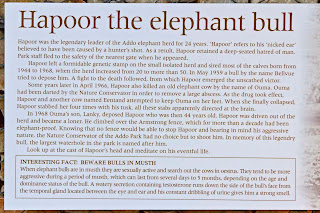SOME HISTORY OF THE ADDO ELEPHANTS
In this day and age of all the alarm and negative sentiment
around the degradation of the natural resources of the world…including
animals….it is easy to become unnecessarily negative. It does us well to be
reminded from time to time of the successful conservation stories of the world.
One of the greatest of these is the Elephants of Addo!
Martin Meredith, in his book “Africa’s Elephant a
biography”, writes:
“By 1760 elephants
could no longer be found south of the Olifant’s River on the western coast of
the Cape Colony; on the eastern coast the nearest elephant strongholds lay 500
miles distant from Cape Town. They remained plentiful on the eastern frontier
for a short while longer. A Swedish scientist, Anders Sparrman, referred in
1775 to incredible numbers there. A government official in 1797 reported a herd
400 strong. But by 1830, when elephant hunting in the Cape Colony was banned,
only two small herds were left in the Eastern Cape, one hidden deep in the
Knysna forest and the other in the Addo bush country. Out of a Cape herd once
estimated at 25 000, no more than a few hundred survived. It was the first mass
extinction since Roman times”.
Fortunately that extinction did not come to pass, but the
Elephants of Addo came perilously close. In fact there were only 11 left!
“The original section
of the park was founded in 1931, in part due to the efforts of Sydney Skaife,
in order to provide a sanctuary for the eleven
remaining elephants in the area. The park has proved to be very successful
and currently houses more than 450 elephants and a large number of other
mammals.” (Wikipedia).
This is some of the history of the Addo Elephant National
Park as recorded in the Information Centre.
The Park Takes Shape
By the early 1900’s most of the large animals had been shot
out and Elephants had become a major problem, damaging crops and competing for
water with farmers.
A number of solutions were attempted over the years, and
these included:
The Extermination of the Elephants.
In 1919 a Major P J Pretorius was tasked with shooting all
of the remaining Elephants. He is reputed to have shot 114 Elephants in 2
years.
The Creation of a Reserve
Feeding the Elephants Orange’s…and finally…
The Erection of the Armstrong Fence.
After some experimentation, in 1953, a concerted effort was
made to erect this fence which is still standing around much of the perimeter
of the Park today. A notable feature of this fence is that it demonstrated that
Big Business and Conservation need to create synergies to create sustainable
projects. In that time the Waygood – Otis Lift Company donated the cabling
required to erect the fence.
The Armstrong fence, enclosing some 2 570 hectares was
completed in September 1954 and changed the atmosphere of the Park forever. The
Elephants became calmer and 6 calves were soon born …3 males and 3 females…..to
the herd of 11 Elephants.
A mere remnant.
Hapoor (photograph and story included) is the only Elephant
to have escaped.
In 1989 the number of Elephants in the Park had risen to
around 100…up from only 11 in 1931. Today that number stands at over
500!!!....140 of which are located in the Nyathi Concession on which River Bend
Lodge is situated. These Elephants were relocated from the main Park in 2003
when 53 Elephants were moved across the R342.
Today Addo is home to one of the largest concentrations of
African Elephants in the world. In 2002 the first bull’s from the Kruger
National Park were introduced into the Park to widen the gene pool. One of
those bull’s in the Nyathi Concession is currently in musth…..and we are seeing
some of his ‘attitude’ in the calves being born which he has fathered.
The Kruger bull referred to in the text above.
The secretion associated with musth clearly visible to the left of his eye.
I find it encouraging that we can see Conservation in
Action….and being successful……and we hope that the ‘Men of Vision’ can apply
this to the situation we are experiencing with the poaching of Rhino’s today!!
Click on this Link (below) and Like to cast your Vote for this photograph (taken in
the Nyathi Concession by the resident photographer at River Bend Lodge) in the
Sunday Times/ GreenLife Photography Competition and raise awareness of one of
the great success stories in modern conservation history...and what the connections are between that image and the story related above are.
When you open the above photograph bear the following in mind:
All of the Elephants in the photograph (barring the male with tusks) are direct descendants of the original 11 Elephants referred to in the text of the Blog. The male is the Kruger bull referred to and photographed, and the calf is very likely the start of the new generation, sired by this bull (Konstalin) in efforts to increase the gene pool. The green shoot in the cow's mouth serves to remind us of our reliance, no matter how big or small we are, of our finite resources provided on earth!
Click on the Images to view a larger version...all Images the Property of River Bend Lodge and may not be used without permission.













